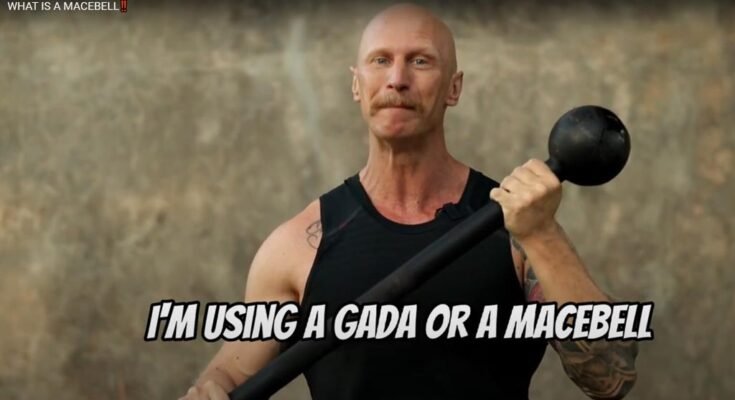A macebell, often confused with its historical counterpart the “mace,” is a modern fitness tool designed to build strength, stability, and flexibility. Resembling a long metal pole with a weighted end, it’s used for dynamic, rotational exercises that challenge the entire body. Whether you’re a seasoned athlete or a fitness newbie, the macebell offers a unique way to enhance functional fitness.
In this article, we’ll explore the macebell’s origins, its benefits, and how to incorporate it into your workouts for maximum results.
The History of the Macebell: From Battle Tool to Fitness Staple
The macebell’s design is inspired by the ancient Persian “meel,” a traditional club used for strength training in South Asian physical culture. Warriors and wrestlers swung heavy wooden clubs (or “gadas”) to build power and endurance for combat.
Today’s macebell adapts this concept into a sleek, adjustable weight system (typically 7–25 pounds) with a steel handle and weighted head. Unlike its historical weapon version, the modern macebell is purely a fitness tool focused on improving mobility and strength.
Types of Macebells
-
Fixed-Weight Macebells: Ideal for beginners, these have a preset weight for consistent training.
-
Adjustable Macebells: Allow you to add or remove weight plates, perfect for progressive overload.
-
Steel Maces: Lighter (4–15 lbs) and often used for fluidity and mobility work rather than heavy lifting.
Top 5 Benefits of Macebell Training
-
Full-Body Conditioning: Engages shoulders, core, back, and grip simultaneously.
-
Rotational Strength: Improves power for sports like golf, tennis, and MMA.
-
Joint Mobility: Circular movements enhance shoulder and hip flexibility.
-
Grip Strength: The offset weight forces your hands and forearms to work harder.
-
Low Impact: Fluid motions reduce strain on joints compared to traditional weights.
How to Use a Macebell: Basic Techniques
1. The 360 Swing
-
Stand with feet shoulder-width apart, gripping the macebell handle with both hands.
-
Swing the mace in a circular motion around your head, pivoting your torso and hips.
-
Keep core engaged and control the momentum.
2. Macebell Front Raise
-
Hold the mace vertically in front of you.
-
Lift the weighted end upward, maintaining a straight back.
3. Squat to Press
-
Lower into a squat while holding the macebell vertically.
-
As you stand, press the mace overhead.
Macebell vs. Other Equipment
-
Kettlebell: Focuses on explosive lifts (e.g., swings), while macebells prioritize rotational patterns.
-
Steel Mace: Lighter and longer, used for flow workouts; macebells are heavier for strength.
-
Dumbbell: Static weight vs. macebell’s dynamic, unbalanced load.
Safety Tips for Beginners
-
Start light (7–10 lbs) to master form.
-
Warm up wrists and shoulders to prevent injury.
-
Avoid over-rotating; let your hips and torso drive movements.
-
Practice in an open space to avoid collisions.
What Muscles Does a Macebell Work?
A macebell is a versatile piece of equipment that primarily targets your shoulders, core, and grip strength, but it also involves a wide range of muscles throughout your body. Here’s a breakdown of the major muscle groups it works:
🔹 Upper Body
-
Shoulders (Deltoids) – Especially during 360s and 10-to-2 swings.
-
Trapezius – Helps stabilize and control the mace during overhead movements.
-
Biceps & Triceps – Activated during pressing, swinging, and pulling motions.
-
Forearms & Grip – Macebells heavily tax grip strength due to their offset weight distribution.
🔹 Core
-
Obliques – Engaged during rotational movements.
-
Rectus Abdominis (Abs) – Stabilizes your torso during swings and holds.
-
Transverse Abdominis – Deep core activation for balance and control.
🔹 Back
-
Lats (Latissimus Dorsi) – Assist in pulling and swinging motions.
-
Erector Spinae – Help maintain posture and spinal alignment.
🔹 Lower Body (in compound movements)
-
Glutes – Engaged in squats, lunges, and rotational exercises.
-
Hamstrings & Quads – Activated during lower body drills with the mace.
-
Hip Flexors – Involved in dynamic, multi-planar movements.
🔸 Summary
The macebell is great for full-body, functional strength, especially improving shoulder mobility, rotational power, and core stabilization. It’s popular in combat sports and functional training for this reason.
🛠️ Macebell Workout Plan (3 Days a Week)
Day 1: Full Body Power & Flow
Focus: Mobility, functional strength, and full-body coordination.
Warm-up (5-7 min)
-
Arm circles
-
Shoulder dislocates (with a stick or light mace)
-
Bodyweight squats
-
World’s greatest stretch
Workout
| Exercise | Sets | Reps/Duration | Notes |
|---|---|---|---|
| Macebell 360s | 4 | 10 each direction | Start light; focus on control |
| Mace Squat + Press | 3 | 10-12 | Full-body activation |
| Mace Uppercut Swings | 3 | 8 each side | Rotational power |
| Mace Around-the-World | 3 | 30 sec each way | Great for shoulder mobility |
| Mace Reverse Lunge + Curl | 3 | 6-8 each leg | Engages legs, arms, and balance |
Finisher
-
2 minutes alternating 360s (every 30 sec switch grip)
Day 2: Core & Stability
Focus: Anti-rotational strength, balance, and core conditioning.
Warm-up (5-7 min)
-
Plank to Down Dog
-
Standing torso twists (light mace)
-
Bird dogs
Workout
| Exercise | Sets | Reps/Duration | Notes |
|---|---|---|---|
| Mace Offset Deadbug | 3 | 10 each leg | Great core activation |
| Mace Russian Twists | 3 | 12-15 | Keep spine neutral |
| Mace Overhead March | 3 | 30 sec | Core + posture |
| Mace Side Bends | 3 | 10-12 each side | Oblique isolation |
| Mace Kneeling Halo Flow | 2 | 45 sec | Shoulder + core stability |
Finisher
-
Plank with mace reach: 3 rounds of 20 seconds per side
Day 3: Shoulders, Back & Grip
Focus: Posterior chain, upper body endurance, and grip strength.
Warm-up (5-7 min)
-
Scapular pull-aparts
-
Mace shoulder rotations
-
Neck mobility drills
Workout
| Exercise | Sets | Reps/Duration | Notes |
|---|---|---|---|
| Macebell 10-to-2s | 4 | 8-10 each side | Explosive movement, grip-heavy |
| Mace Bent-Over Rows | 3 | 12-15 | Back and grip |
| Mace Snatch to Overhead | 3 | 6-8 | Power and coordination |
| Mace Static Hold (Offset) | 3 | 30 sec each side | Core + grip + shoulder burn |
| Mace Clean & Press | 3 | 6-10 | Full upper-body work |
Finisher
-
Macebell Farmer Carry: 2 x 40 steps with offset load
🧠 Tips
-
Rest 30–60 seconds between sets.
-
Perform dynamic stretches before and mobility drills after workouts.
-
Start light (7–10 lb mace) and progress as you gain control and strength.
-
Track your reps to gauge progress!
FAQs About Macebells
Q: Is a macebell the same thing as a steel mace?
A: Not quite. While the terms are often used interchangeably, there is a difference. Steel maces are typically longer and lighter, designed for more flow-based training. Macebells, on the other hand, tend to be shorter and heavier, making them better suited for strength-focused exercises. Think of the macebell as the tougher cousin in the same family.
Q: I’m totally new—can I still train with a macebell?
A: Definitely! Macebells are beginner-friendly as long as you start with the right weight and learn proper form. For most people, starting with a 10-pound macebell is ideal. The movements may feel a little awkward at first, but that’s normal—give your body time to adapt, and focus on smooth, controlled reps. Mastering the basics now will set you up for serious gains later.
Q: What muscles does the macebell actually target?
A: A macebell might look simple, but it delivers a full-body workout. It primarily targets your shoulders, upper back, and core, but also works your grip, forearms, and even your legs—especially when you integrate movements like squats or lunges. It’s a sneaky way to train strength, stability, and mobility all at once.
Q: How heavy should my first macebell be?
A: This is one of the most common questions—and it’s an important one. If you’re just starting out and don’t have much experience with uneven or offset weights, stick with a 10 lb macebell. It may sound light, but because all the weight is at the end of the handle, it feels much heavier than it looks. If you’re more advanced or have solid shoulder mobility, you might try a 15-pounder.
Q: Can I actually get a cardio workout using a macebell?
A: Yes—and it’ll probably surprise you. Macebell training isn’t just about slow, controlled swings. Once you learn the flow and start stringing movements together, it turns into a full-body cardio session. High-rep circuits, fast-paced transitions, and dynamic moves can elevate your heart rate just like a HIIT workout—except with more functional strength benefits.
Q: Is macebell training good for preventing injuries?
A: Absolutely. One of the biggest perks of macebell training is how it strengthens your stabilizing muscles—especially in the shoulders, core, and wrists. These muscles often get neglected in traditional weightlifting, which can lead to imbalances and injuries down the line. The rotational and offset loading of the macebell builds resilience in a way few tools can match.
Q: How much space do I need to train with a macebell at home?
A: You don’t need an entire garage gym—just a bit of open space. If you have about a 6-foot radius around you, you’re good to go. Outdoor spaces like a backyard or park are also great options. Just make sure you’re not swinging near anything breakable (or anyone you like).
Conclusion: Is the Macebell Right for You?
The macebell is a versatile tool for anyone looking to improve functional strength, mobility, and athletic performance. Its unique design challenges your body in ways traditional weights can’t, making it a standout addition to home gyms or CrossFit boxes.
Ready to try macebell training? Begin with foundational movements, prioritize form, and gradually increase intensity. Pair it with kettlebells or resistance bands for a well-rounded routine.
Explore our recommended macebell equipment to start your journey today!




hi
Hi Tommyliady! Welcome to T7Fit.com – we’re excited to support your fitness journey!
It’s great to have you here. How can I help you today?